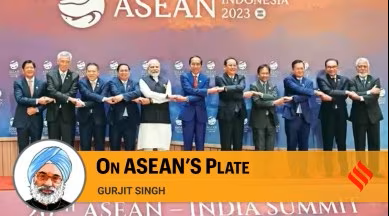ASEAN’s China dilemma
- October 30, 2023
- Posted by: admin
- Category: ASEAN & ARF

The Indonesian presidency must be complimented for keeping ASEAN on an even keel, despite its many challenges. In a dynamic world, the stability of ASEAN remains important
Written by Gurjit Singh
At the ASEAN meet earlier this month, Indonesia succeeded in putting new nuances into often contentious ASEAN positions. Indonesia’s ASEAN chairmanship was the high point of President Joko Widodo’s term, since he will not compete in the 2024 elections. Eight ASEAN countries came together at the highest level. As is usual now, Myanmar was not invited at the political level for the Jakarta Summit; Thailand is in the throes of constituting a new government.
At the meet, Indonesia’s plan included an initiative to embrace the Indo-Pacific. It arranged the first ASEAN Indo-Pacific Forum (AIPF), which had government leaders from ASEAN, some of its partners and a large number of participants from the business sector. Over 60 speakers in diverse panels sought a peace dividend and enhanced prosperity in the region. In his address to the AIPF, Widodo called for expanding the arc of prosperity and for ASEAN. This was the recognition that global economic growth was now centred in the Indo-Pacific region.
Indonesian interlocutors took pains to emphasise that not only did they embrace the Indo-Pacific without worrying too much about what China may say, they also adopted a functional approach to the Indo-Pacific. This is akin to the Quad’s soft approach to the Indo-Pacific — seeing it more as a cooperative venture than a strategic concept.
Is this a nuanced balance of China? Nobody wanted to answer this question. While the US, UK, Canada, Australia and India did side events, China was conspicuous by its absence from the AIPF.
Where Myanmar is concerned, Indonesia realises the limits of the Five-Point Consensus (5PC). It did not let the Thai initiatives derail the ASEAN position, but accommodated them. Unlike Cambodia and Brunei, Indonesia did not appoint a person as special envoy, but opened an office of the special envoy, quietly engaging with Myanmar, its neighbours, including India, and other ASEAN countries. Indonesia also engaged with Myanmar opposition parties, though not with their armed groups. Indonesia is now no longer seeing the 5PC as a binding decision but a facilitating initiative and hopes that efforts to engage with Myanmar’s different sections will soften the blow. There is no optimism that this could be a quick solution. ASEAN decided that Myanmar would not host the 2026 summit, in which Myanmar itself has lost interest. In the past, ASEAN used the privilege of hosting a summit to seek remedy in Myanmar’s actions. Whether this leverage will work now remains uncertain.
China remains the major challenge for ASEAN, in particular, with regard to big-power rivalry in the region. Its call for peace and prosperity is a muted way of saying that the US and China will not exhibit their rivalry in the region. The progress on the code of conduct is slow and repeated emphasis on the United Nations Convention on the Law of the Sea appears as a sticking point between the ASEAN’s and China’s views on the South China Sea (SCS). The matter was complicated by the issue of what China calls its new standard map, which annoys many countries whose territories are shown as part of China. Besides India and Japan, the Philippines, Vietnam, Malaysia and Indonesia raised it bilaterally with China. Indonesia played it quiet mainly because it was the host of the ASEAN and East Asia Summit (EAS), which the Chinese Premier attended.
Such assertions contradict the progress that ASEAN claims have been made on the code of conduct, which, after all, is for the SCS as an international waterway and not as a domestic sea of China, as their map claims.
The closer embrace of the ASEAN Outlook on Indo-Pacific (AOIP), the willingness to have more ASEAN coordination among their coast guards and to have a common exercise among their defence forces have been a robust response to the lack of achievement on the code of conduct.
However, as ASEAN asserts its centrality, its unity has question marks. Myanmar was unrepresented. Thailand’s slow transition after an election led to an official-level representation. In this light, there is a movement under Indonesia’s chairmanship of coordinated rules on how ASEAN should act in the absence of a consensus. Emergent situations cannot wait for a time-consuming 10-country consensus. This means that decision making could move away from a full consensus into a coalition of the willing.
The Indonesian presidency must be complimented for keeping ASEAN on an even keel, despite its many challenges. In a dynamic world, the stability of ASEAN remains important. Indonesia has formed a troika with the next chairs — Laos and Malaysia — to steer the course ahead.
